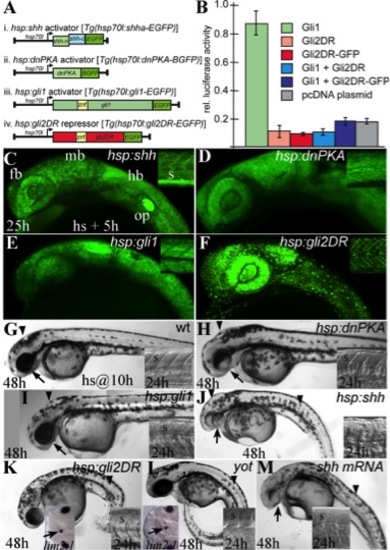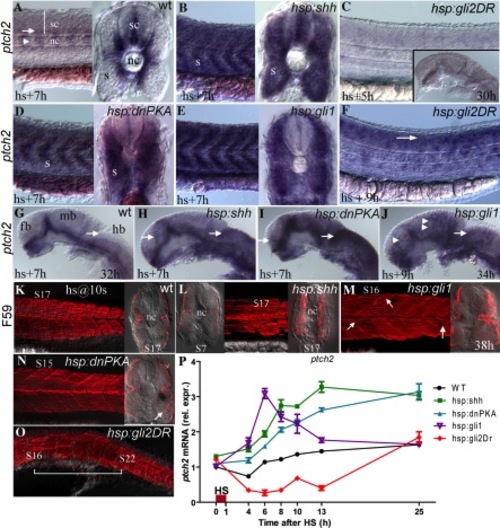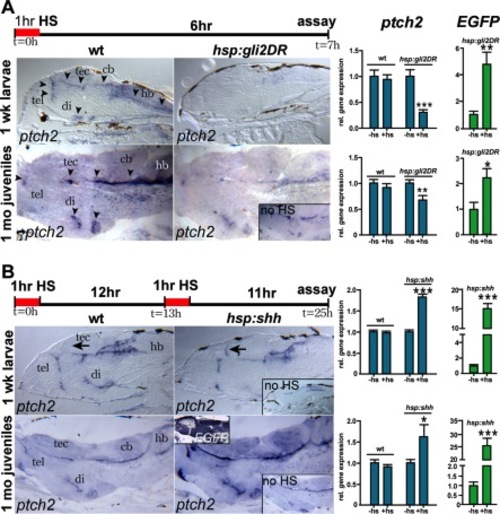- Title
-
Heat-shock?mediated conditional regulation of hedgehog/gli signaling in zebrafish
- Authors
- Shen, M., Ozacar, A.T., Osgood, M., Boeras, C., Pink, J., Thomas, J., Kohtz, J., and Karlstrom, R.O.
- Source
- Full text @ Dev. Dyn.
|
Heat-shock?inducible activation and repression of Hedgehog (Hh) signaling. A: Four transgene constructs designed to allow heat-shock manipulation of Hh/Gli signaling. (i) hsp:shh activator line [Tg(hsp70l:shha-EGFP)]: (ii) hsp:dnPKA activator line [Tg(hsp70l:dnPKA-BGFP)]: (iii) hsp:gli1 activator line [Tg(hsp70l:gli1-EGFP)]. (iv) hsp:gli2DR repressor line [Tg(hsp70l:gli2DR-EGFP)]. B: Luciferase reporter assay. The modified Gli2DR protein and the Gli2DR-EGFP fusion protein caused an 80% reduction in luciferase activity in the presence of Gli1. C?F: Live images of 25 hours postfertilization (hpf) transgenic embryos, 4 hr after the completion of a 1-hr heat shock. Insets show green fluorescent protein (GFP) expression in the somites of the trunk. C: In the hsp:shh line, diffuse GFP expression is consistent with cytoplasmic localization of the Shhc-term-EGFP fusion protein. D,E: Cytoplasmic expression of the dnPKA-BGFP fusion and Gli1-EGFP fusion proteins. F: The Gli2DR-EGFP fusion protein is localized to nuclei. G?K: 48 hpf embryos that were heat shocked at 10 hpf. G: Wild-type embryo, inset shows V-shaped somites at 24 hpf. H: hsp:dnPKA embryo displaying Hh over expression defects including ventrally reduced eyes (arrow), dorsal brain defects (arrowhead), and slightly flattened somites at 24 hpf typical of Hh over-expressing embryos (Koudijs et al., 2008). I: hps:gli1 embryo with no visible Hh over-expression defects. Somites appear morphologically normal at 24 hpf (inset). J: hsp:shh embryo showing more severe Hh gain of function defects including flattened somites (arrowhead and inset) and reduced eyes (arrow). K: hsp:gli2DR embryo showing defects associated with a loss of Hh signaling, including U-shaped somites (arrowhead and right inset) and ventrally positioned but well formed eyes. lim2.1 labeling reveals an ectopic midline lens (arrow, left inset) in a 30 hpf hsp-gli2DR embryo that was heat shocked at the 8-somite stage. L: Forty-eight hpf yot(gli2DR) mutant embryo with Hh loss of function defects including u-shaped somites (arrowhead and right inset) and a lim2.1-labeled ectopic midline lens (left inset, arrow). M: Hh overexpression defects in the somites (arrowhead) and forebrain (arrow) caused by injection of 100 pg of shh mRNA at the 2-cell stage. fb, forebrain; hb, hindbrain; mb, midbrain; op, otic placode; s, somite. |
|
Timing and relative magnitude of Hedgehog (Hh) signal manipulation. A: Wild-type ptch2 expression in the trunk at 32 hours postfertilization (hpf). Cross-section shows spinal cord and somite ptch2 expression. B: Dramatically expanded ptch2 expression in the hsp:shh line 7 hr after heat shock. Cross-section shows dorsal expansion in the spinal cord and lateral expansion throughout the somites. C: ptch2 expression is dramatically reduced 5 hr following heat-shock?induced activation of the gli2DR-GFP transgene in the trunk and head (inset). D,E: ptch2 expression is expanded in both the somites and spinal cord in the hsp:dnPKA (D) and hsp:gli1 (E) transgenic lines 7 hr after heat shock. F: Nine hours following heat-shock treatment of the hsp:gli2DR line ptch2 expression reappears, with expression expanded into inappropriate dorsal domains of the spinal cord (arrow). G: Normal ptch2 expression in the head of a wild-type embryo 7 hr after heat shock. H?J: Dorsally expanded ptch2 expression in hsp:shh, hsp:dnPKA, and hsp:gli1 activator lines,7 and 9 hr after heat shock, respectively. J: Ectopic and mosaic ptch2 expression was consistently seen in the hsp:gli1 line (arrowheads). K: F59 antibody labeling reveals the normal slow muscle fiber distribution in a 38 hpf wild-type embryo that was heat shocked at the 10-somite stage (14 hpf). Cross-section of somite 17 shows the lateral position of these slow muscle fibers. L: Heat-shock activation of the hsp:shh transgene at the 10-somite stage led to ectopic slow muscle fiber differentiation starting at somite 16?17. Left panel shows normal slow muscle fibers in somite 7, which had differentiated before heat shock. Middle panel shows lateral view of trunk, with disrupted fiber visible starting around somite 17. Right panel shows a cross-section of somite 17 with increased numbers of slow muscle fibers. M,N: hsp:gli1 and hsp:dnPKA lines show subtle somite morphology defects (arrows). O: Activation of the hsp:gli2DR transgene at the 10-somite stage led to a loss of slow fibers starting at somite 16. Slow fiber differentiation appears relatively normal in somite 23, indicating Hh signaling was no longer blocked when this somite was forming. P: Time course of ptch2 mRNA expression in all four lines following a 1 hr heat shock starting at 24 hpf. Symbols report the mean value (± SEM) for each treatment at a given time point, error bars are visible only if larger than symbols. fb, forebrain; hb, hindbrain; mb, midbrain; nc, notochord; s, somite; sc, spinal cord. |
|
Heat-shock?induced manipulation of Hedgehog (Hh) signaling at larval and juvenile stages. A: Reduced ptch2 expression in the ventricular regions of the brain 6 hr post heat shock in hsp:gli2DR transgenic 1-week-old larvae (compare top two panels) and 1-month-old juveniles (bottom two panels), as visualized by in in situ hybridization (ISH). Quantitative polymerase-chain reaction (qPCR) analysis revealed that ptch2 mRNA levels were reduced approximately 70% and 30% relative to non?heat-shocked 1-week and 1-month transgenics, respectively (right). EGFP mRNA levels were increased 4.8- and 2.2-fold in larvae and juveniles, respectively. B: Regionally increased Shh signaling in double heat-shocked hsp:shh transgenic fish visualized by ISH. In larvae, ptch2 expression was similar to non?heat-shocked transgenic and wild-type fish when examined by ISH, with ectopic expression seen in the anterior tectum (arrows). In juveniles, ptch2 expression was increased in its normal expression domain. No changes in ptch2 gene expression were seen in non?heat-shocked transgenic fish (right insets). EGFP mRNA was induced throughout the central nervous system in juveniles (inset). qPCR analysis revealed 1.8- and 1.6-fold increases in ptch2 expression in larvae and juveniles, respectively. EGFP mRNA levels were increased 15- and 25-fold, indicating effective heat-shock activation of the transgene at both ages. cb, cerebellum; di, diencephalon; hb, hindbrain; tec, tectum; tel, telencephalon. ***P < 0.001, **P < 0.01, *P < 0.05. |
|
Transgenic zebrafish lines that report Hedgehog (Hh) signaling. A,B: Live 24 hours postfertilization (hpf) embryos imaged using a fluorescent dissecting microscope. The Tg(GBS-ptch2:EGFP) (A) and Tg(GBS-ptch2:nlsEGFP) (B) lines accurately report Hh signaling in responding tissues of the floor plate, ventral brain, and somites. Only the (Tg(GBS-ptch2:EGFP) line has inappropriate green fluorescent protein (GFP) expression in the otic placode (A, arrowhead). C: Confocal image of the head of an nlsEGFP expressing embryo showing expression in Hh responsive regions of the brain (compare with ptch2 in situ labeling in F). D,E: Confocal images of the trunk region in live 24 hpf nlsEGFP (D) and enhanced GFP (EGFP) (E) transgenic embryos show appropriate nuclear or cytoplasmic GFP labeling (arrowheads). GFP intensity in the spinal cord allows visualization of the ventral-to-dorsal Shh signaling gradient (triangles) (Stamataki et al., 2005). More laterally, GFP is expressed in Hh responsive slow muscle fibers (arrowheads). F: Shh responsive regions of the brain visualized by ptch2 ISH. G,H: In situ labeling for GFP mRNA is the same as the known ptch2 expression pattern in the brain (G) and trunk (H). I: GFP expression in the spinal cord and somites in an uninjected Tg(GBS-ptch2:EGFP) embryo. J?L: ptch2 and GFP mRNA expression are eliminated when embryos are treated with the Hh signaling inhibitor cyclopamine (Incardona et al., 1998). M: Dorsally expanded GFP expression following injection of Shha encoding mRNA. N: GFP expression in a live 8-day-old Tg(GBS-ptch2:EGFP) larvae includes the floor plate (arrowhead) and retinal ganglion cell axons of the eye (arrow). O: Sagittal section through the brain of a 6-month-old Tg(GBS-ptch2:EGFP) adult co-labeled to show neurons (HuC/D antibody) and nuclei (dapi). Retinal ganglion cell axons express EGFP in the optic chiasm and where they terminate in the tectum (arrowheads). Ventricular regions of the brain continue to be Hh responsive in adults (arrow). cb, cerebellum; di, diencephalon; fp, floor plate; hb, hindbrain; nc, notochord; oc, optic chiasm; op, otic placode; r, rhombomere; s, somite; tec, tectum; tel, telencephalon; zli, zona limitans interthalamica. |




